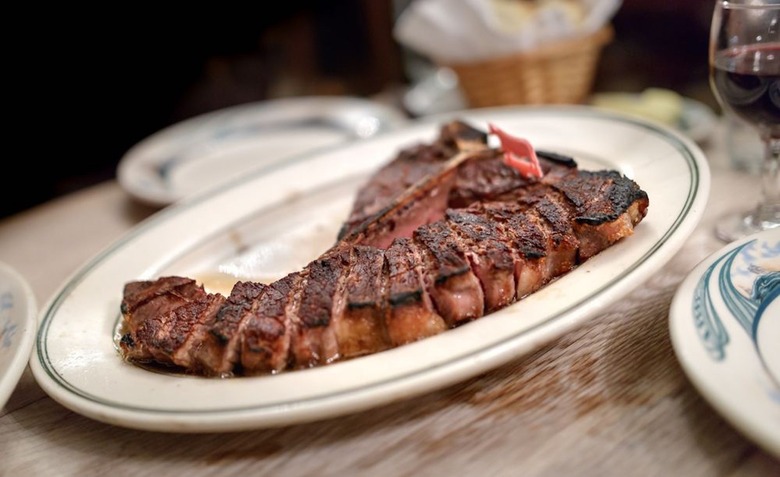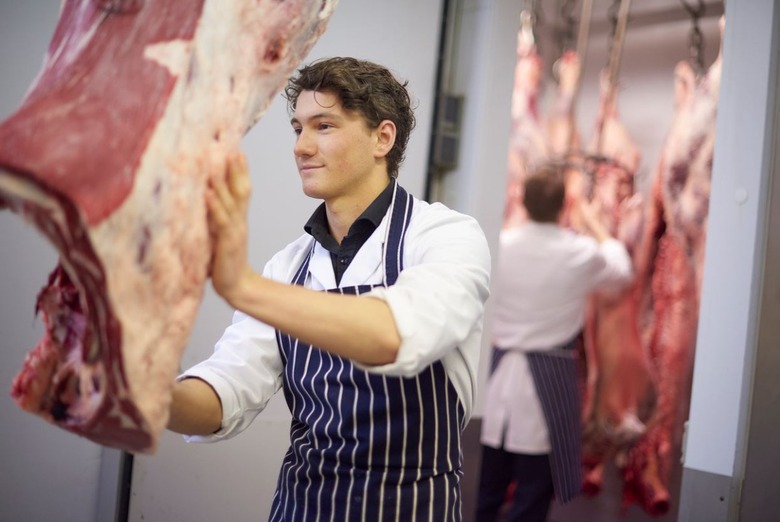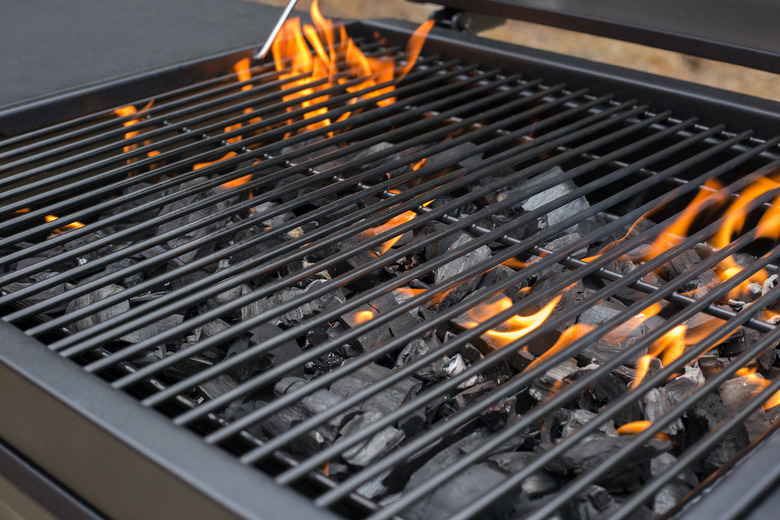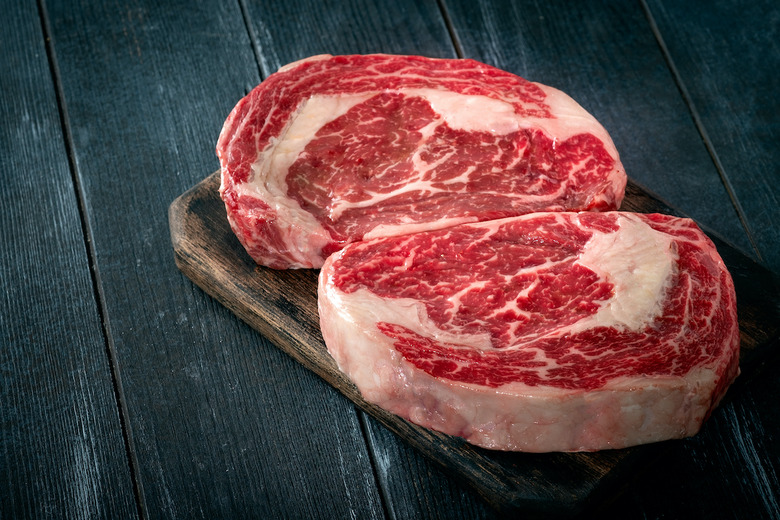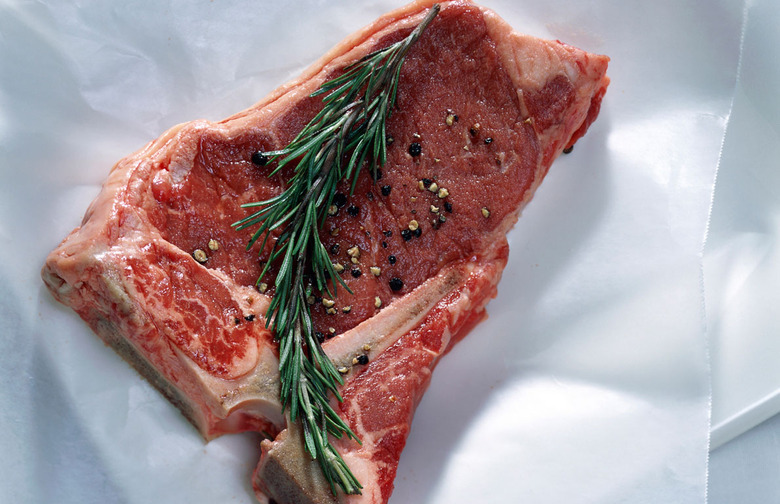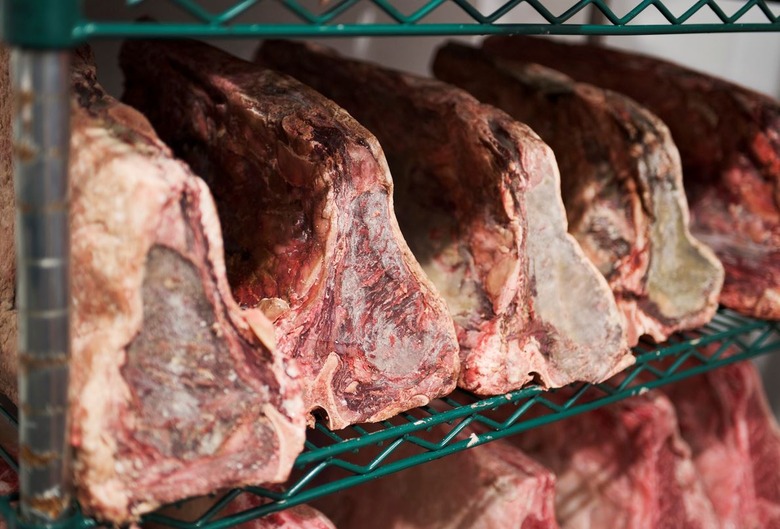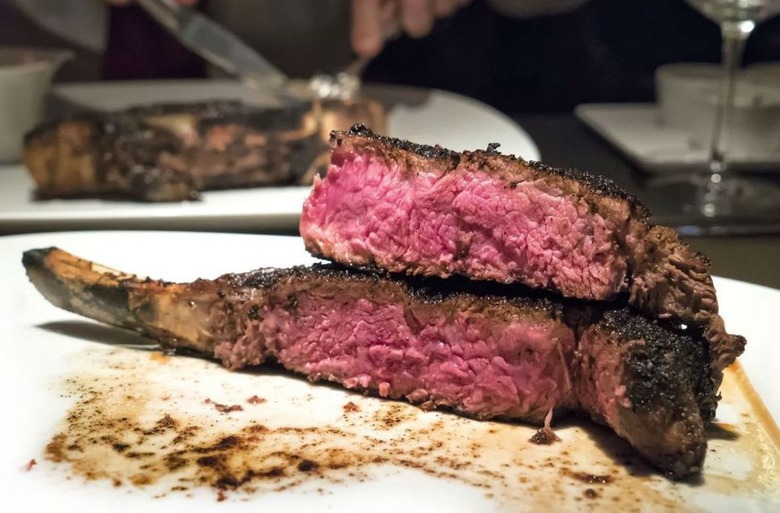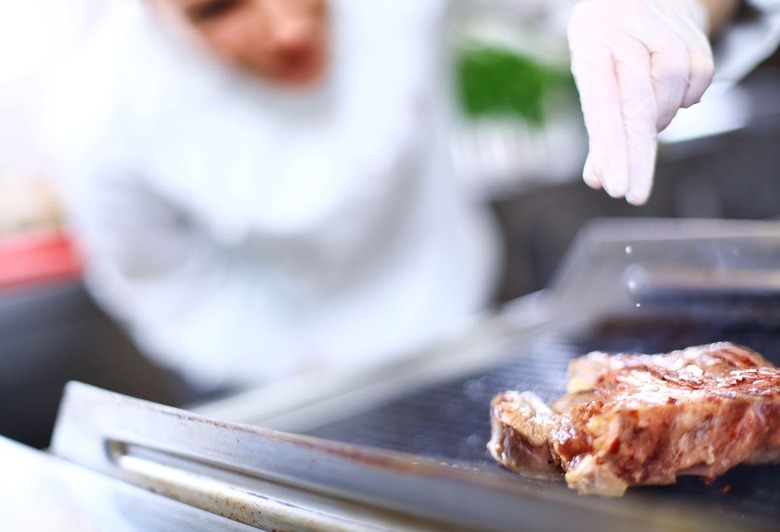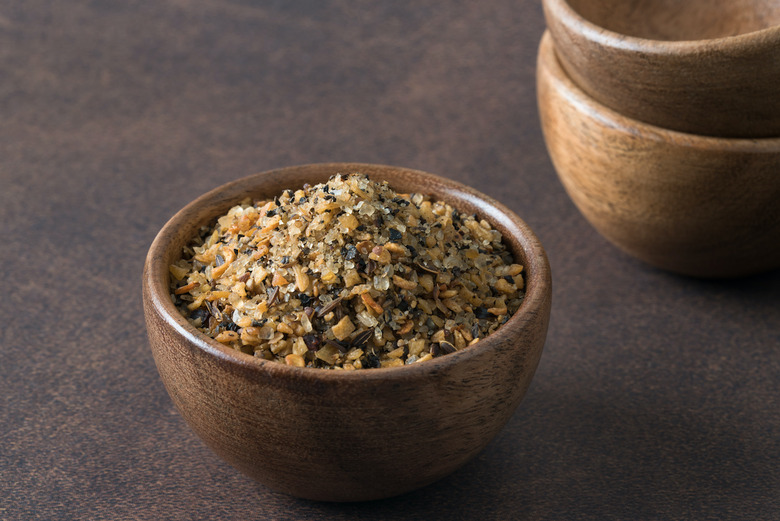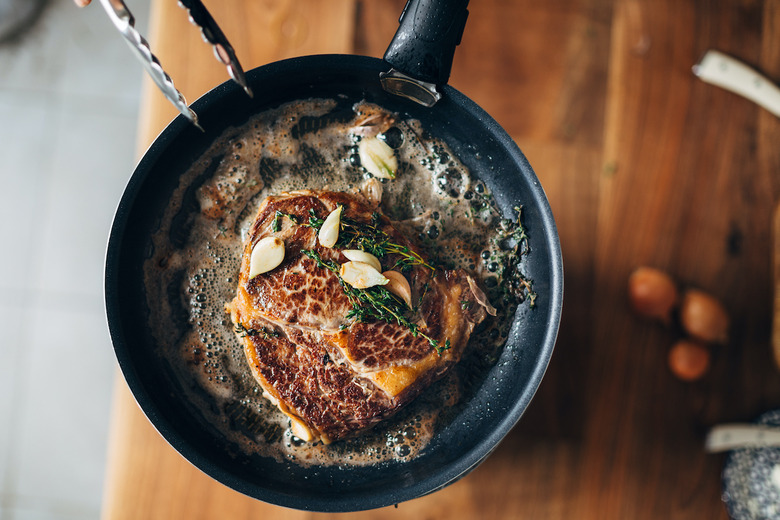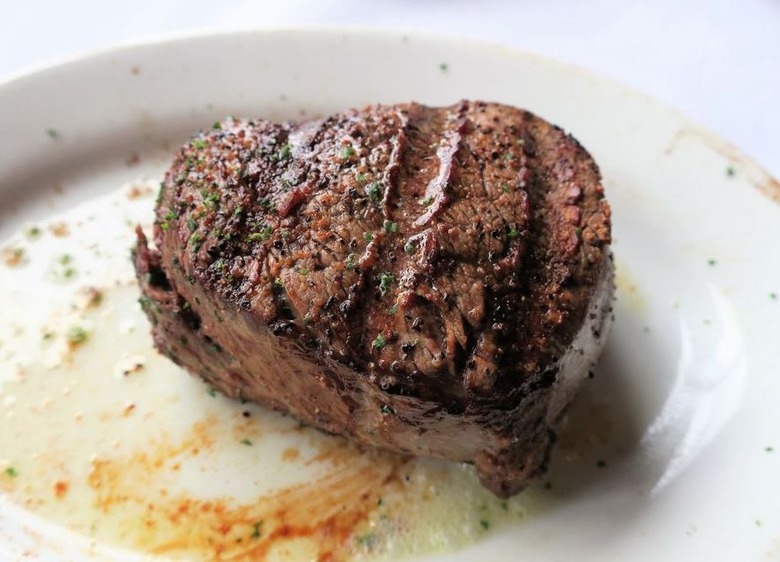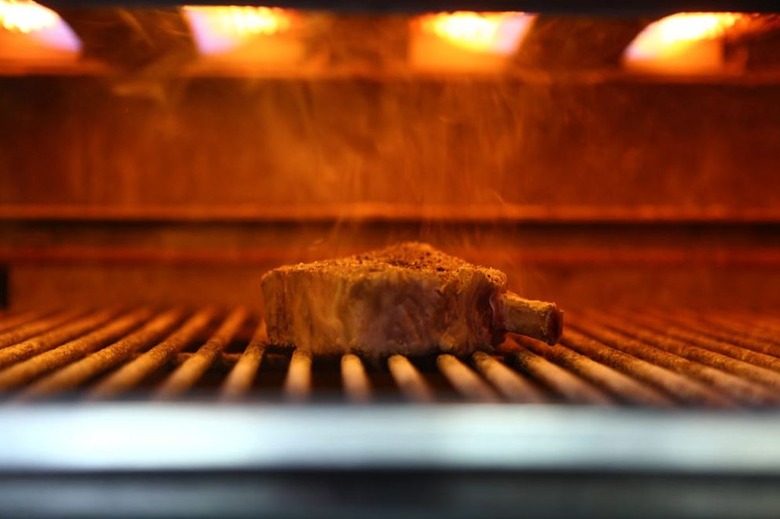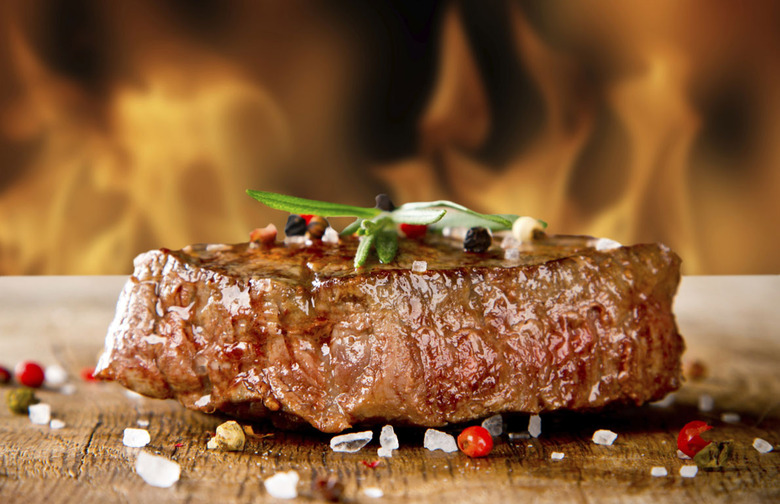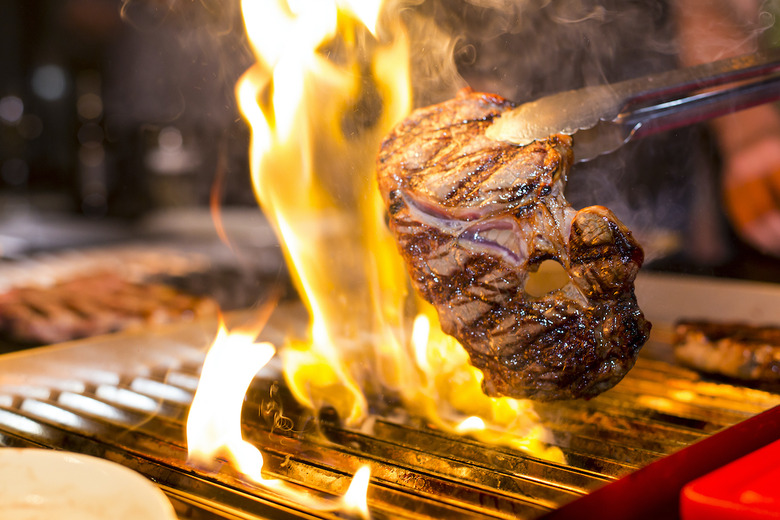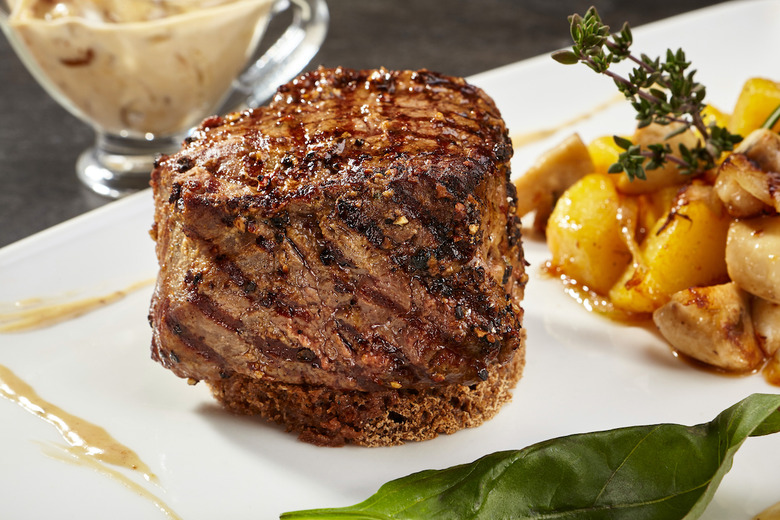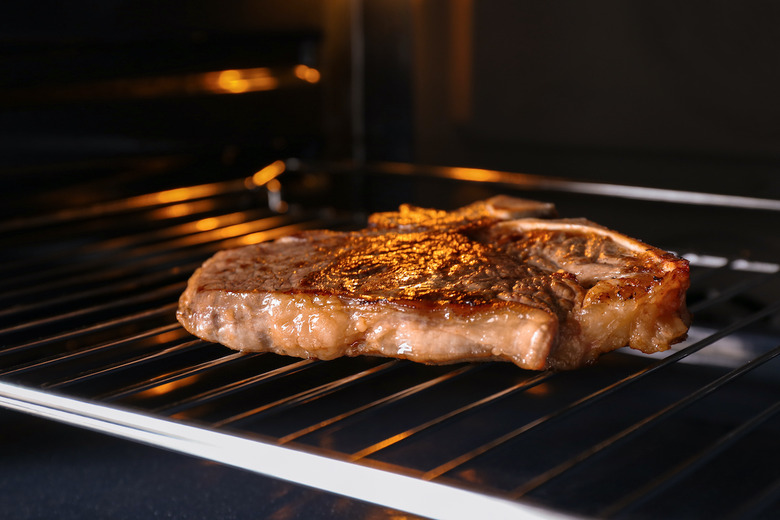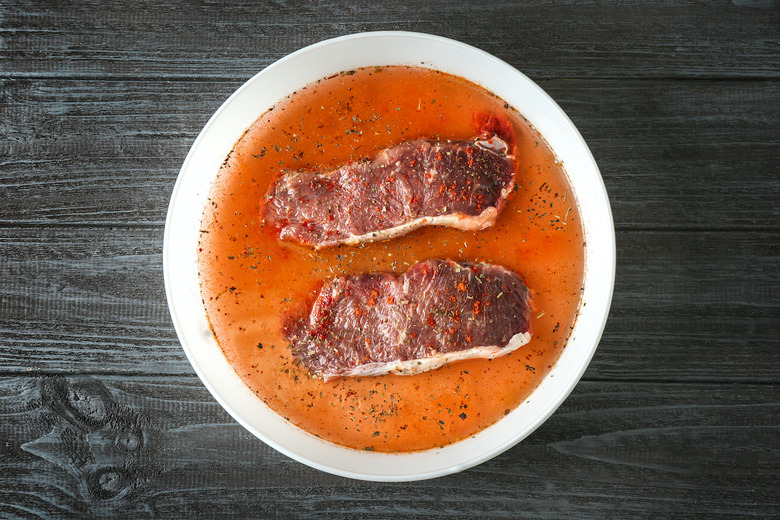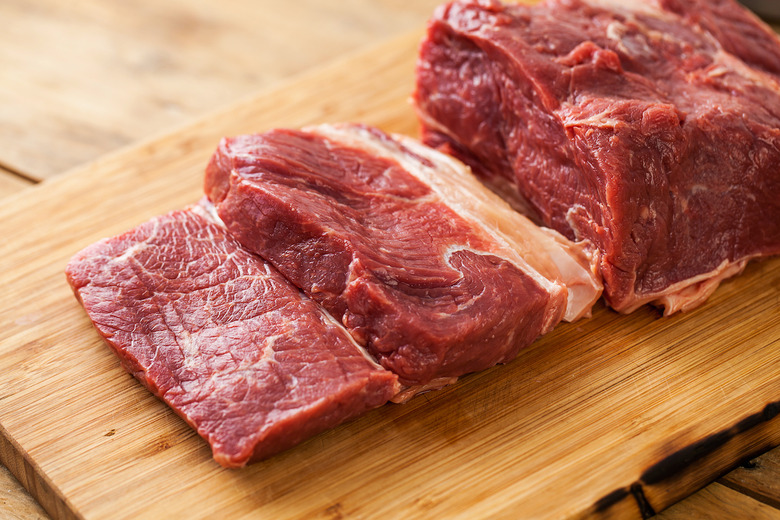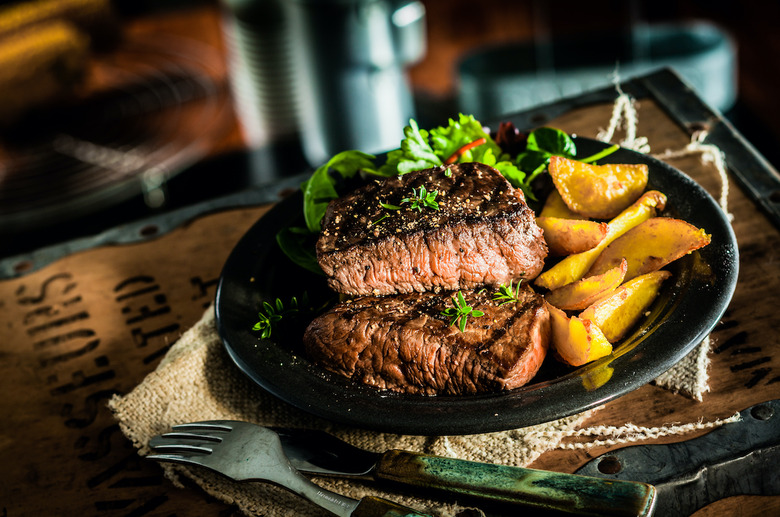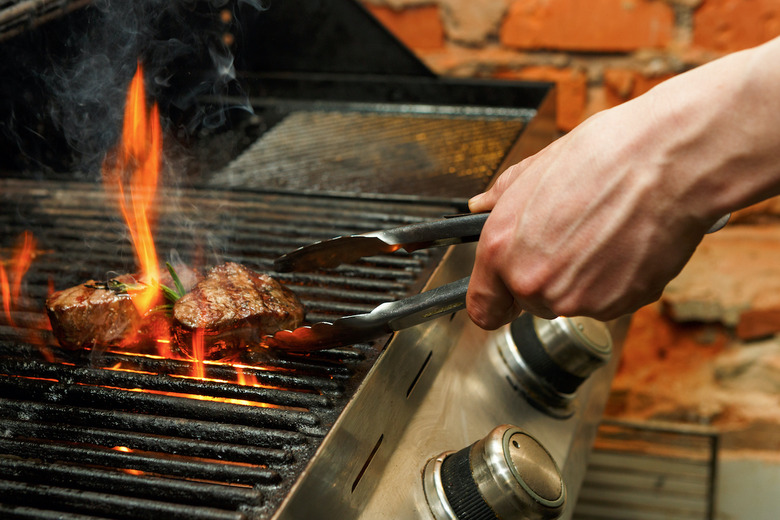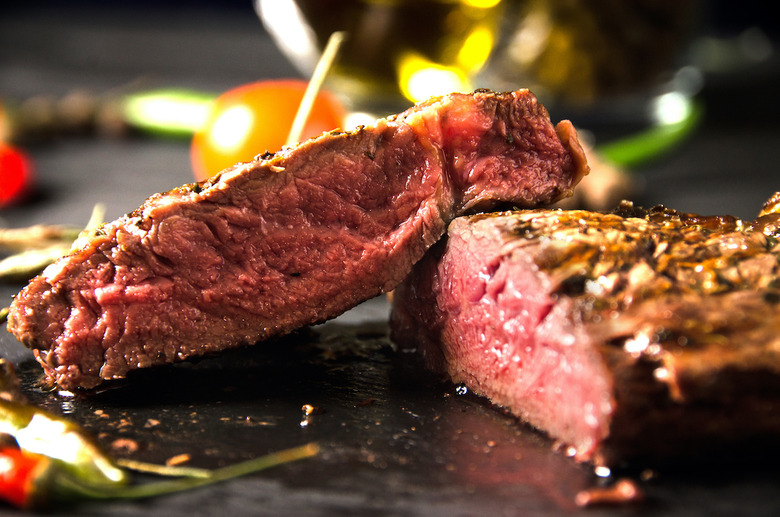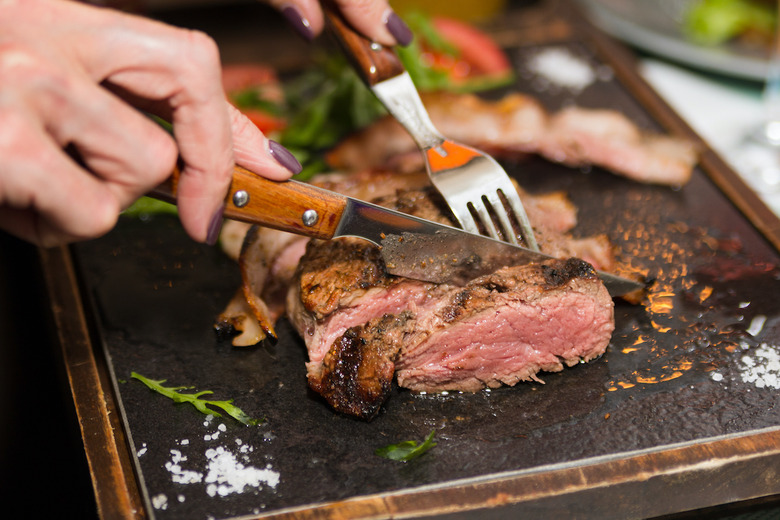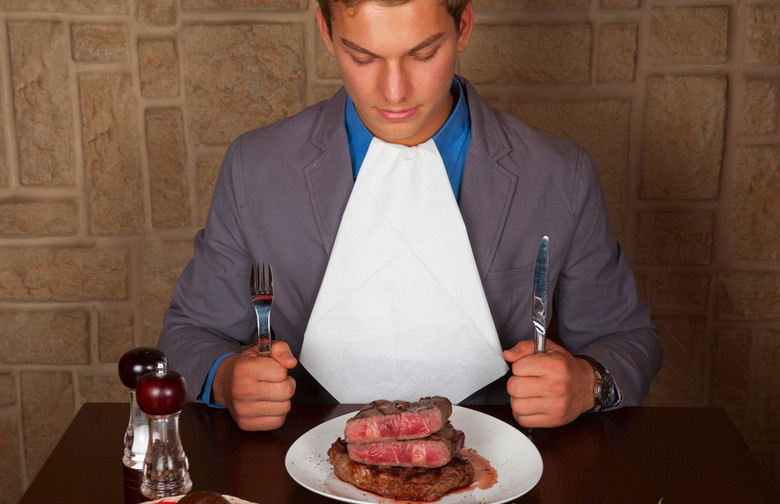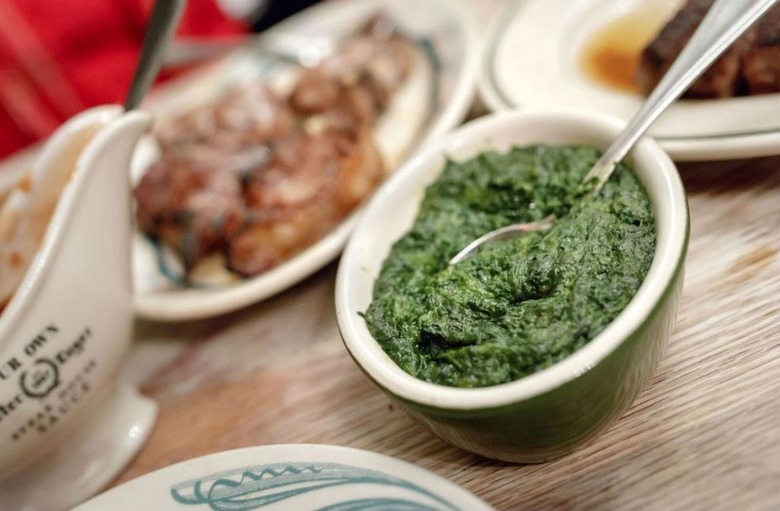Steakhouse Secrets Only The Experts Know
There are few culinary experiences like the one you get at a great steakhouse. However, the perfect cut, the perfect seasoning and the perfect temperature can be hard to replicate at home. So how exactly do the chefs turn out steaks that are so tender and delicious? The Daily Meal has gathered these expert tricks that make those steaks so good, with a few tips you can use right in your own kitchen.
They work closely with butchers
Top steakhouses don't just grab any steak they see at the store — they work with butchers and, in some cases, head out to the packing house to inspect the meat themselves before selecting it for the restaurant. They'll look for things like marbling, color and fat distribution. Check with your local shop to see if they offer butchering as one of their special grocery store amenities.
They use USDA prime steaks
Many steakhouses use USDA prime steaks — but what does that mean? To achieve that ranking, the steak needs to have the highest level of marbling, or intramuscular fat, and be from young cows. You might not be able to find USDA prime beef at your local supermarket, but some high-end stores and butcher shops would be a good place to check.
They use fresh, never frozen steaks
Chef Michael Senich of LongHorn Steakhouse says that while frozen steaks may be cheaper and last longer, you sacrifice the quality of the beef. Freezing a steak can lead to ice crystals or freezer burn, and improper thawing can make it hard to cook a steak to the desired temperature. For best results, he says to always go with fresh steak. Frozen produce, on the other hand, can be just as good as fresh.
They start with a clean grill
At LongHorn Steakhouse, Senich says all grillmasters start with a clean grill so a quality cut of steak won't stick to it. To clean your grill at home, first, scrape the grill grates with a brush. Then, dip a hand towel in canola oil with a pair of tongs and run it along the grates as the grill is warming up. For more on this specific method of cooking, here are tips on how to grill the perfect steak every time.
They let the steak rest before cooking
Fernando Garcia, director of culinary operations for Black Angus Steakhouse, says to pull steaks from the fridge and let them rest at room temperature for 20 to 30 minutes prior to cooking. Letting meat come to room temperature before cooking is just one of the best tips and tricks for cooking steak, chicken and other meats correctly.
Some wet-age their steaks
Some steakhouses serve "wet-aged" beef, which is essentially steak that's been stored in an airtight, vacuum-sealed plastic bag for a few days or even up to six weeks. While wet-aged beef is more tender than beef that hasn't been aged at all, it's a lot less robustly flavored than its more upscale counterpart, dry-aged beef.
Some dry-age their steaks
Many great steakhouses dry-age their beef for anywhere from two to three weeks, and sometimes much longer. In order to dry-age beef, whole primal cuts (large pieces of meat carved out at butchering) are stored in a temperature- and humidity-controlled room and carefully monitored. When ready to serve, the layer of mold that has formed on the meat's surface is removed before it's cut into steaks, and the end result has a more robust, earthy flavor that steakhouse fans know and love.
They use super thick steaks
Steaks at high-end steakhouses are usually well over an inch thick, sometimes approaching 2 inches. Not only is a super-thick steak a lot more impressive-looking on the plate than a half-inch one, but the thickness also gives the broiler a lot more time to go to work on caramelizing the outer crust. If it were a thin steak in that broiler, the center could be overcooked before a nice crust had time to develop.
They use lots and lots of salt
Steakhouse cooks liberally apply salt to a steak before it goes into the broiler, typically using kosher or sea salt. Morton Salt invented the phrase, "When it rains, it pours," so let that salt pour when seasoning your steaks at home.
They don’t always stop at salt, though
Black Angus' Garcia suggests adding your favorite spices to a mix of salt and pepper to season before cooking. Garlic and onion powders are great savory flavors in the rub, he says. And while you're in your spice drawer, channel your inner Marie Kondo and clean out any expired or duplicate spices.
They go beyond spices
For maximum flavor, Shula's corporate chef and culinary director Demetrio Zavala first seasons steak with salt and pepper. He then waits for a pan to preheat over medium heat and, once it smokes lightly, he adds a teaspoon of canola oil and places the steak inside. He allows the steak to cook for two minutes on each side to reach medium-rare. Then, he adds butter, fresh thyme and whole garlic cloves to the pan. Spoon the butter from the pan over the steak. This is called basting, which adds moisture and flavor to the surface of the meat, Zavala says. If peeling garlic is a pain for you, here are easy hacks from restaurant chefs.
They use a lot of butter
You know that sizzling effect that Ruth's Chris is famous for? That's the result of adding a big dollop of butter to the pan right before the steak is served. Steakhouses use all sorts of techniques to make sure their steaks are juicy and flavorful, but many steakhouses aren't afraid to use a whole lot of butter.
They use infrared broilers
That deep, dark, caramelized crust on steaks from great steakhouses? You can thank an infrared broiler for that. While some steakhouses still grill or griddle their steaks, many including Bobby Van's, The Palm Restaurants and Morton's use infrared broilers, which superheat large surfaces to an even temperature. Some steakhouses depend on these broilers to cook their steaks, and while they can be difficult to master, the end result is a steak with a nice crust.
They use super-high heat
If you were to attempt to cook a steak at home with the same amount of heat that steakhouses use, you'd end up with a very smoky kitchen and maybe even a fire on your hands. Those infrared broilers can reach temperatures of over 1,000 degrees Fahrenheit and can cook a 2-inch-thick steak in a matter of minutes. Even the ovens that the steaks are finished in often reach temperatures of more than 500 degrees. "We use commercial-grade broilers that cook proteins at very high temperatures," David Holben, executive chef of Del Frisco's Double Eagle Steakhouse, told The Daily Meal. "The home kitchen equipment used only performs to a certain level, which has a ceiling on its output of BTUs, or heating capacity."
They flip frequently
According to LongHorn Steakhouse's Senich, to cook the meat evenly on both sides of a steak, grillmasters flip it every three to four minutes.
They let it rest after cooking
Humans aren't the only ones who need rest. Senich says the biggest mistake that at-home grillers make is cutting into the steak too early, which allows the moisture to drip out. Before taking the finished product out to the dining room, LongHorn Steakhouse lets every steak sit for one to two minutes to make sure it stays juicy when the diner cuts into it.
They use different cooking methods for different cuts
According to Bridget Wasser, executive director of meat science, culinary and supply chain at the National Cattlemen's Beef Association, tender steaks like strip, rib-eye and T-bone can be cooked with dry-heat methods including grilling and broiling. The best way to cook less tender steaks like flank, skirt, round and chuck is by using moist-heat cooking methods like braising or slow-cooking to elevate tenderness. Or, they can be cooked with dry-heat methods, like grilling, if tenderizing marinades are applied prior to cooking.
They marinate cuts that need it
For less tender steaks like flank, skirt or round, Wasser suggests a tenderizing marinade that contains acidic ingredients such as lemon juice, flavored vinegar or even Dr. Pepper as well as natural enzymes like ginger or pineapple. Allow a fourth- to a half-cup of marinade for every pound of beef and marinate for six to 12 hours in the refrigerator — never at room temperature. Dry rubs and marinades work best when cooking beef on a grill, Wasser says. Avoid pastes or marinades with high sugar content to minimize burning.
Some cut their own beef
Wasser says to consider buying larger roasts from your grocery store or butcher and trimming them into steaks to save more money and get the exact thickness you want. Ribeye, strip loin and tenderloin are easiest to cut into steaks at home, she says. Pull the roast directly from the fridge to cut into steaks, as beef is easier to slice when it's cold. And make sure to cut steaks to uniform thickness so they cook evenly.
They brown, but not too much
Before cooking, pat steaks dry with paper towels for better browning, Wasser suggests. This elevates the natural, great flavor of beef.
They don’t use forks while cooking
When flipping steaks, use tongs instead of forks, Wasser says. Using a fork will pierce the beef and result in a loss of flavorful juices.
They use a meat thermometer
Temperature is the best indicator of doneness, Wasser says. Insert an instant-read thermometer horizontally from the side so it penetrates the thickest part of the steak, not touching bone or fat. Resist cutting into steaks to check for doneness while cooking. You'll lose juices and risk drying out the beef. Keep in mind that the temperature of the steak will continue to rise for a few minutes after cooking.
Don’t have a meat thermometer? No problem
To check the doneness of your steak without a meat thermometer, Vanderlei Melchior, gaúcho chef and area manager at Fogo De Chão, says to open the palm of one hand and touch the fleshy area between your thumb and base of your palm on the other. That's what raw meat feels like. For well done, press your thumb to your pinky and touch the same area with the opposite index finger. Repeat with your thumb and middle finger for medium-rare and your thumb and index finger for rare to know the feel you're looking for in your steak.
They slice correctly
If you're slicing a steak before serving it, cut across the grain for optimal tenderness. Slicing across the grain means slicing perpendicular to the direction of the fibers, which makes the meat more tender and easier to chew, Wasser says. Also, when slicing less tender cuts across the grain, slice thinly to further elevate tenderness.
Their steaks are high in calories
Well-marbled steaks contain a lot of fat, and with the addition of butter and other cooking oils, the calorie count of a steakhouse dinner could be high. For example, a 12-ounce slow-roasted prime rib from Outback Steakhouse has 1,050 calories and has 86 grams of fat, and that's without any sides. Even if you order something like couscous, some better-for-you restaurant sides aren't as healthy as you think.
They elevate the experience with wine pairings
You can elevate your steaks at home with the proper wine pairings. According to Kendall-Jackson vineyard and winery, filet mignon goes best with pinot noir, New York strip goes best with cabernet sauvignon, rib-eye goes best with zinfandel, porterhouse goes best with syrah, and skirt and flank go best with merlot and sauvignon blanc, depending on the final preparation and accompaniments.
They complete the meal with side dishes
A perfect steak can be delicious on its own, but the pros know that a steakhouse meal is incomplete without a side or two. Creamed spinach, a big baked potato, onion rings, creamed corn and macaroni and cheese are up there with the most iconic sides. Sides should definitely accompany your meal if you're looking to have a perfect steakhouse experience at home. If you own a grill, there are so many things you can make beyond steak with these easy grilling recipes for steak, chicken, pizza and more.
More from The Daily Meal:
How to Cook Chicken, Turkey, Steak and 12 Other Foods Correctly
America's Best Inexpensive Steakhouses
Grilled Chicken Recipes That Aren't Boring
